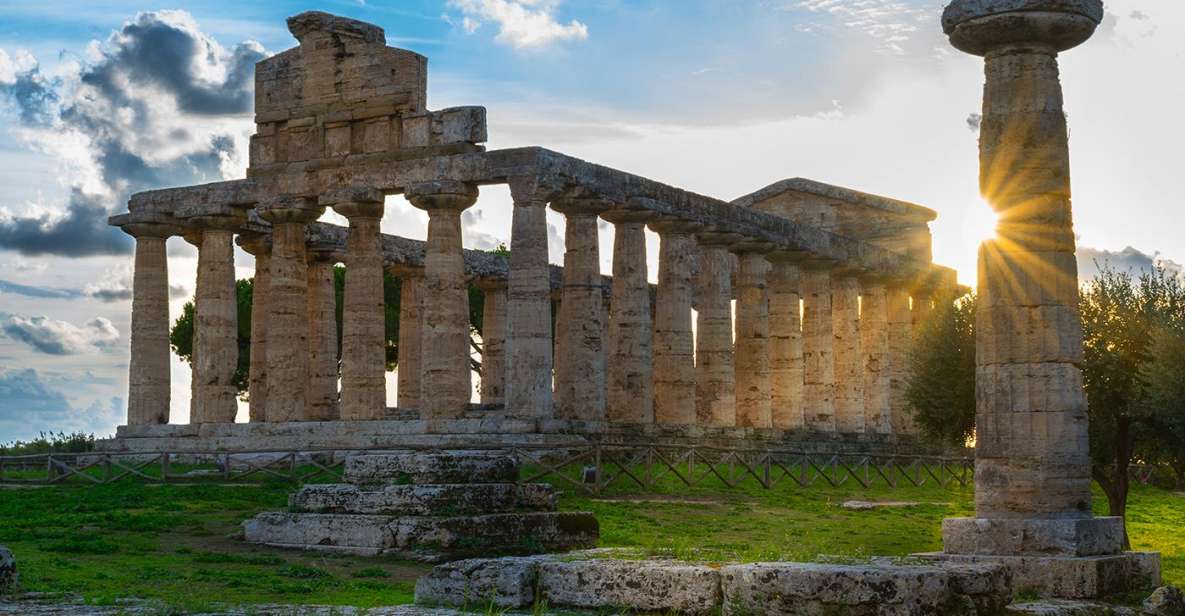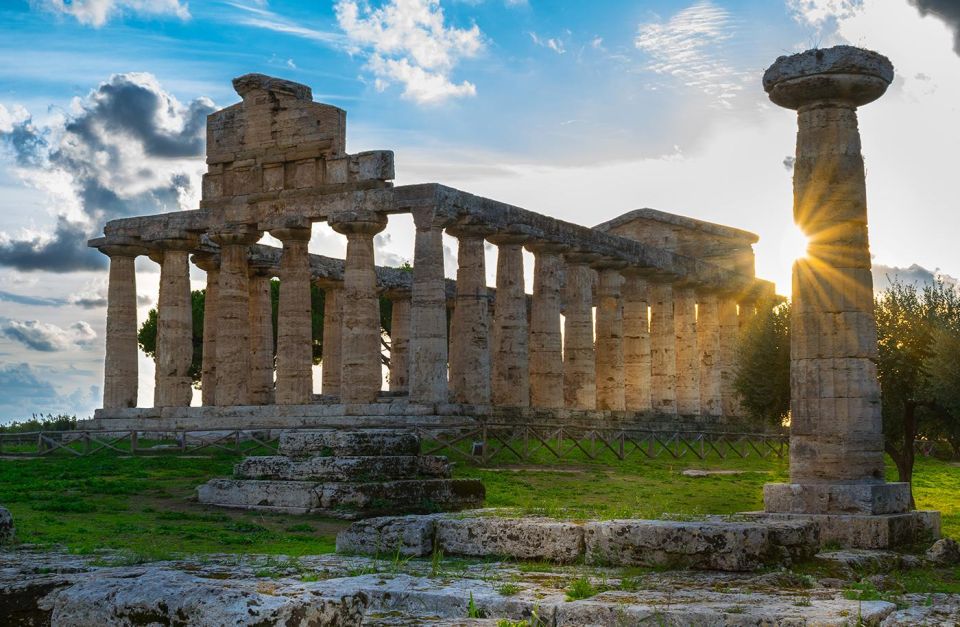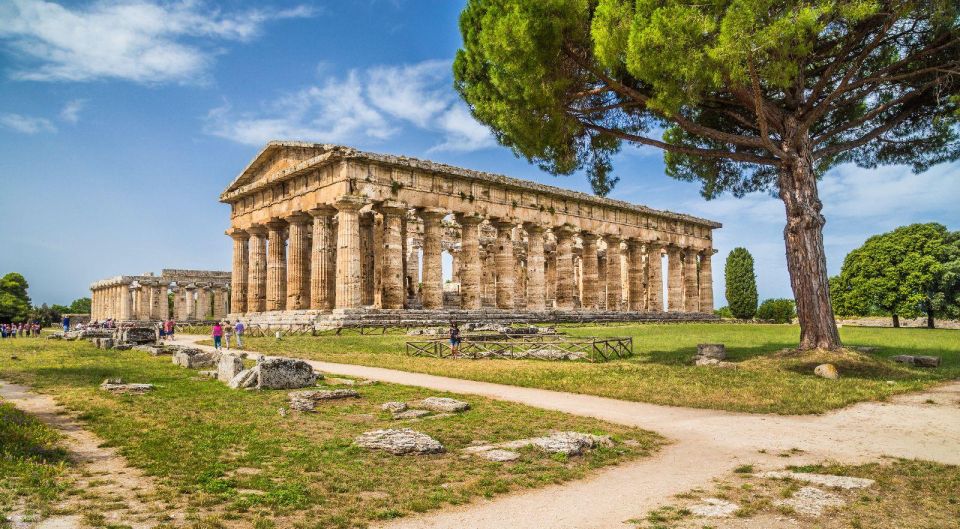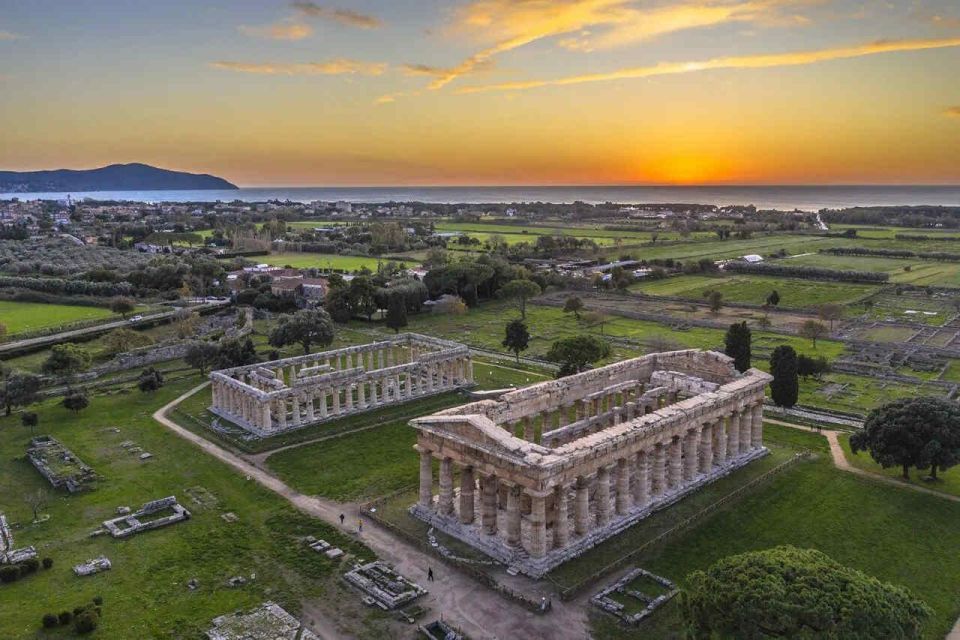Nestled along the stunning Tyrrhenian coastline, the ancient Greek city of Paestum beckons travelers to uncover its rich historical legacy. Founded in the 7th century BC, this prosperous member of Magna Graecia boasts remarkable Doric temples that stand as testaments to the city’s architectural and engineering prowess. Visitors can explore the well-preserved ruins, seeing the cultural heritage and artistic achievements that defined Paestum’s golden era. From the iconic temples to the evocative archaeological treasures, the city’s timeless ambiance invites you to discover the enduring legacy of this remarkable ancient site.
Key Points

- Explore the ancient Greek foundations of Paestum, a prosperous member of Magna Graecia, founded around the 7th century BC by Greek settlers.
- Marvel at the iconic Greek temples, including the Temple of Hera, Temple of Neptune, and Temple of Athena, showcasing the architectural feats of ancient Paestum.
- Discover the remarkable engineering and design principles behind Paestum’s architectural marvels, such as the precisely crafted Doric columns and harmonious proportions.
- Uncover the archaeological treasures of Paestum, including intricate mosaics, frescoes, and a wealth of artifacts that provide insights into the city’s daily life and artistic achievements.
- Experience the timeless ambiance of Paestum, where towering Greek temples and ancient city walls transport visitors on a journey through the mists of history.
Exploring Paestum’s Greek Foundations

Tracing Paestum’s Greek origins reveals a city-state that once flourished as a prosperous member of Magna Graecia, the ancient Greek settlements scattered across the southern Italian peninsula.
Founded around the 7th century BC by Greek settlers from Sybaris, the city was known as Poseidonia in antiquity. Its strategic location along the Tyrrhenian Sea facilitated trade and cultural exchange, allowing Paestum to thrive.
The remarkable Greek temples, such as the Temple of Hera and Temple of Neptune, stand as testaments to the city’s architectural and engineering feats. Visitors can explore these majestic structures, which exemplify the ingenuity and craftsmanship of ancient Greek builders, transporting them back to Paestum’s illustrious past.
You can also read our reviews of more tours and experiences in Paestum.
Iconic Temples of Ancient Paestum

Among the most iconic structures in ancient Paestum are its exceptionally well-preserved Greek temples, which continue to captivate visitors with their architectural grandeur and historical significance.
The Temple of Hera, dating back to the 6th century BC, is one of the oldest and best-preserved Doric temples in the world, showcasing the ingenuity and craftsmanship of ancient Greek architects.
The Temple of Neptune, also from the 6th century BC, exemplifies the mastery of the Doric order, while the Temple of Athena exhibits a harmonious blend of Doric and Ionic styles.
These magnificent temples offer a window into the rich cultural heritage and religious practices of ancient Paestum, transporting visitors through the mists of time.
Architectural Marvels of Paestum

Boasting an impressive architectural legacy, Paestum’s remarkably well-preserved Greek temples continue to captivate visitors with their timeless beauty and engineering prowess. These iconic structures, dating back to the 6th century BC, exemplify the remarkable achievements of ancient Greek architects and builders.
Key features include:
-
Meticulously Crafted Doric Columns: The towering, fluted columns of the Temple of Hera and Temple of Neptune showcase the precision and sophistication of Doric architecture.
-
Harmonious Proportions: The temples’ harmonious proportions, with precise measurements and attention to detail, highlight the Greeks’ mastery of mathematical principles in design.
-
Innovative Structural Techniques: The temples’ innovative use of stone blocks and load-bearing systems demonstrate the ingenuity of their builders.
-
Blending of Architectural Styles: The Temple of Athena’s fusion of Doric and Ionic elements showcases the adaptability and creativity of Paestum’s architects.
Uncovering Paestum’s Archaeological Treasures
Beneath the well-preserved Greek temples, Paestum’s archaeological treasures paint a vivid picture of the city’s rich cultural heritage.
Visitors can explore intricate mosaics and frescoes that adorn the floors and walls of ancient structures. Delicately crafted artifacts, including pottery, jewelry, and sculptures, offer glimpses into the daily lives and artistic achievements of Paestum’s residents.
The necropolis, or ancient cemetery, provides insight into burial practices and funerary rituals. Excavated residential areas reveal the layout and infrastructure of the ancient city, while the imposing city walls and gates demonstrate the strength and strategic importance of Paestum.
Each archaeological discovery unlocks a new chapter in the city’s captivating history.
More Great Tours NearbyPaestum’s Roman and Medieval Legacies

Paestum’s Roman conquest ushered in a new era of architectural and administrative evolution, as the once-Greek city adapted to its new overlords. The Romans constructed a grand forum, complete with temples, basilicas, and markets, showcasing their engineering prowess.
Plus, they built an impressive amphitheater, where residents and visitors alike could witness thrilling spectacles.
During the medieval period, Paestum continued to evolve, with the construction of fortified walls and towers to protect against invaders. Remnants of a Benedictine abbey and a Norman castle further illustrate the site’s diverse history.
As visitors explore Paestum’s ancient ruins, they can uncover the layered legacies left by the Romans and medieval settlers, offering a window into the city’s enduring significance.
Experiencing Paestum’s Timeless Ambiance
As visitors explore the timeless ruins of Paestum, they’re immersed in a captivating ambiance that transcends the boundaries of time. Towering Greek temples, hewn from sun-kissed limestone, stand as eternal sentinels guarding the secrets of a bygone era.
The ancient city walls, with their rhythmic patterns of light and shadow, invite visitors to imagine the bustling life that once filled these streets. Wandering through the evocative archaeological site, one can almost hear the echoes of ancient voices, the clatter of hooves, and the lapping of waves against the Tyrrhenian shore.
Paestum’s timeless beauty and immersive experience transport visitors on a journey through the mists of history, connecting the present with the enduring legacy of the past.
Paestum’s Cultural and Artistic Achievements
Paestum’s cultural and artistic achievements are showcased through an array of well-preserved artifacts and architectural marvels that offer a glimpse into the city’s vibrant past.
Visitors can marvel at:
- Intricate mosaics adorning the floors of ancient villas, depicting mythological scenes and everyday life.
- Exquisite frescoes that once adorned the walls of buildings, showcasing the skill of Paestum’s artists.
Visitors can also admire:
- Intricately-carved stone reliefs and statues that exemplify the city’s mastery of sculptural techniques.
- Beautifully-crafted pottery, jewelry, and other artifacts that highlight the city’s thriving craftsmanship and trade networks.
These remarkable finds not only captivate visitors but also provide invaluable insights into the cultural and artistic sophistication of ancient Paestum.
Visitors exploring the archaeological site of Paestum can navigate through the well-preserved ruins of this ancient Greek city, seeing its timeless grandeur.
The city’s ancient walls, stretching over 4.5 kilometers, provide a framework for exploring the various architectural and archaeological wonders.
Within the walls, visitors can discover the iconic Greek temples, each showcasing the exceptional craftsmanship and engineering of the ancient builders.
The Roman Forum, thermal baths, and amphitheater offer glimpses into the city’s later history, while the residential areas and necropolises provide insights into daily life.
With every step, travelers are transported back in time, gaining a deeper appreciation for the rich cultural heritage of Paestum.
Frequently Asked Questions
How Did Paestum Obtain Its Original Name of Poseidonia?
Paestum was originally known as Poseidonia, named after the Greek god Poseidon. The city was founded around the 7th century BC by Greek settlers from Sybaris, who established the colony and named it in honor of the sea deity.
What Industries or Trades Contributed to Paestum’s Economic Prosperity?
Paestum’s strategic coastal location facilitated thriving trade in agricultural goods, seafood, and artisanal crafts. Its prosperous economy also benefited from the city’s role as a cultural hub within Magna Graecia, attracting visitors and merchants from across the Mediterranean.
Are There Any Specific Ancient Festivals or Rituals That Took Place in Paestum?
Paestum was home to ancient Greek festivals and rituals honoring the gods, such as elaborate processions and sacrifices at the city’s iconic temples. These religious events were integral to the cultural and social life of the community.
How Have Modern Excavations and Conservation Efforts Impacted the Site?
Modern excavations and conservation efforts have transformed Paestum, uncovering more of its ancient wonders and preserving the iconic Greek temples. Ongoing work continues to reveal the site’s rich history and make it more accessible to visitors.
What Are Some Unique Geological or Environmental Features of the Paestum Region?
The Paestum region boasts unique geological features, including the Cilento Coast’s dramatic cliffs and the nearby Alburni Mountains. Its coastal location and temperate Mediterranean climate have also influenced the area’s flora and fauna over the centuries.
Recap
Paestum’s captivating ruins and timeless ambiance transport visitors to an era of ancient Greek grandeur.
The well-preserved temples, archaeological treasures, and enduring cultural legacy offer a transformative journey through time, inviting travelers to enjoy the city’s rich history and artistic achievements.
Exploring Paestum’s ancient foundations, visitors discover the enduring significance of this remarkable archaeological site.
You can check availability for your dates here:More Tour Reviews in Paestum
Not for you? Here's more nearby things to do in Paestum we have reviewed
- Paestum for cruise passengers
- Cilento Wine: Tour & Tasting Experience
- Mozzarella Experience: Tour + Lunch in Paestum’s dairy
- Paestum: powered paragliding flight over the temples
- Wine tasting in Cilento with professional sommelier.
- Paestum: Small-Group Tour with an Archaeologist and Tickets
- Paestum: City Orientation Tour
- In the heart of Cilento: nourish your soul
- 12 Best Tours In Paestum
- 5 Best Guided Tours In Paestum
- 2 Best Private Tours In Paestum
- Sailing Experience in Cilento
